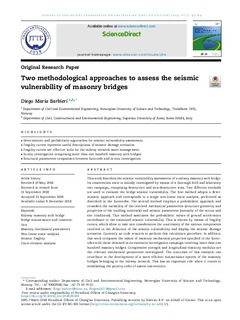| dc.contributor.author | Barbieri, Diego Maria | |
| dc.date.accessioned | 2019-09-24T11:10:55Z | |
| dc.date.available | 2019-09-24T11:10:55Z | |
| dc.date.created | 2019-01-11T16:31:02Z | |
| dc.date.issued | 2019 | |
| dc.identifier.citation | Journal of Traffic and Transportation Engineering (English Edition). 2019, 6 (1), 49-64. | nb_NO |
| dc.identifier.issn | 2095-7564 | |
| dc.identifier.uri | http://hdl.handle.net/11250/2618466 | |
| dc.description.abstract | This work describes the seismic vulnerability assessment of a railway masonry arch bridge. Its conservation state is initially investigated by means of a thorough field and laboratory test campaign, comprising destructive and non-destructive tests. Two different methods are used to evaluate the bridge seismic vulnerability. The first method adopts a deterministic approach and corresponds to a single non-linear static analysis, performed as described in the Eurocodes. The second method employs a probabilistic approach and considers the variability of the involved mechanical parameters (structure geometry and properties of the building materials) and seismic parameters (intensity of the action and site conditions). This method associates the probabilistic values of ground acceleration exceedance to the estimated seismic vulnerability. This is shown by means of fragility curves, which allow to take into consideration the uncertainty of the various components involved in the definition of the seismic vulnerability and display the seismic damage scenarios. Currently no code requires to perform this calculation procedure. In addition, this work compares the values of masonry mechanical properties specified in the Eurocodes with those obtained in an extensive investigation campaign involving more than one hundred masonry bridges. Compressive strength and longitudinal elasticity modulus are the relevant mechanical parameters investigated. The outcomes of this research can contribute to the development of a more efficient maintenance system of the masonry bridges belonging to the railway network. This has an important role when it comes to establishing the priority order of assets intervention. | nb_NO |
| dc.language.iso | eng | nb_NO |
| dc.publisher | Elsevier | nb_NO |
| dc.rights | Attribution-NonCommercial-NoDerivatives 4.0 Internasjonal | * |
| dc.rights.uri | http://creativecommons.org/licenses/by-nc-nd/4.0/deed.no | * |
| dc.title | Two methodological approaches to assess the seismic vulnerability of masonry bridges | nb_NO |
| dc.type | Journal article | nb_NO |
| dc.type | Peer reviewed | nb_NO |
| dc.description.version | publishedVersion | nb_NO |
| dc.source.pagenumber | 49-64 | nb_NO |
| dc.source.volume | 6 | nb_NO |
| dc.source.journal | Journal of Traffic and Transportation Engineering (English Edition) | nb_NO |
| dc.source.issue | 1 | nb_NO |
| dc.identifier.doi | 10.1016/j.jtte.2018.09.003 | |
| dc.identifier.cristin | 1655258 | |
| dc.description.localcode | Open Access CC-BY-NC-ND | nb_NO |
| cristin.unitcode | 194,64,91,0 | |
| cristin.unitname | Institutt for bygg- og miljøteknikk | |
| cristin.ispublished | true | |
| cristin.fulltext | original | |
| cristin.qualitycode | 1 | |

